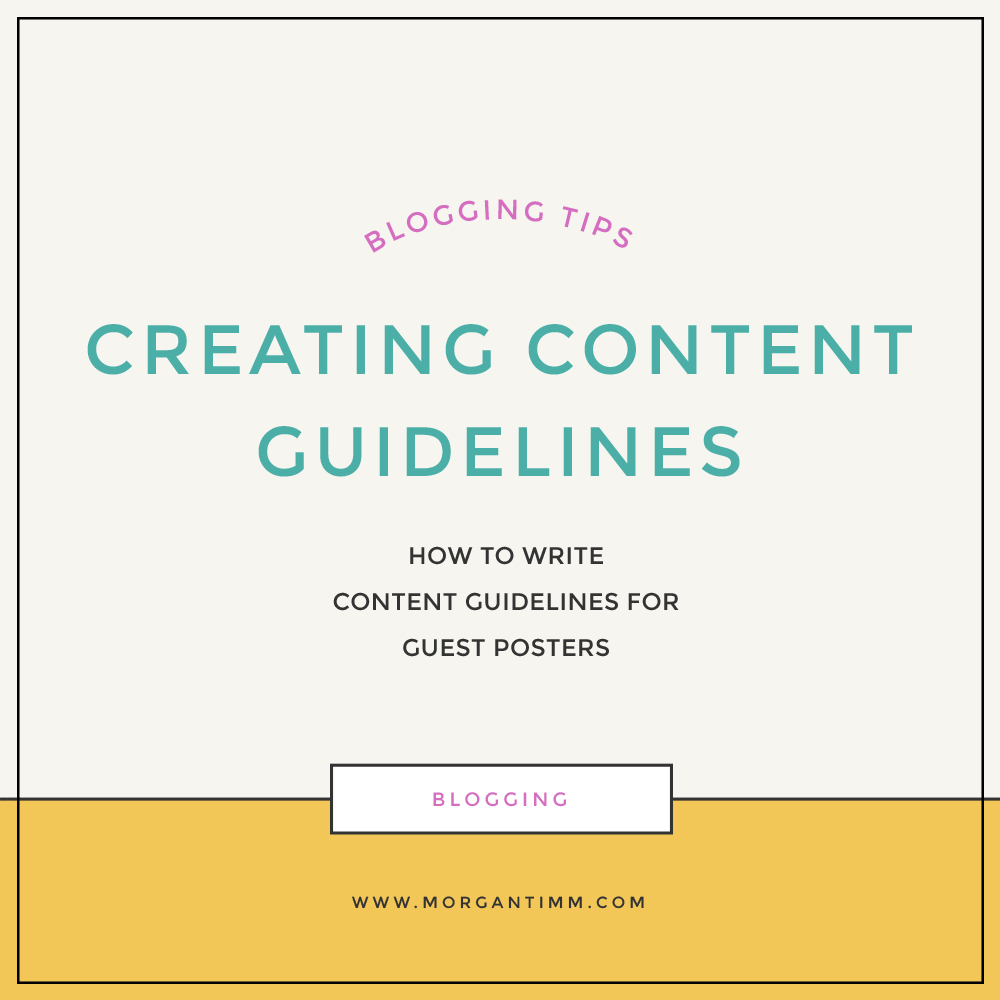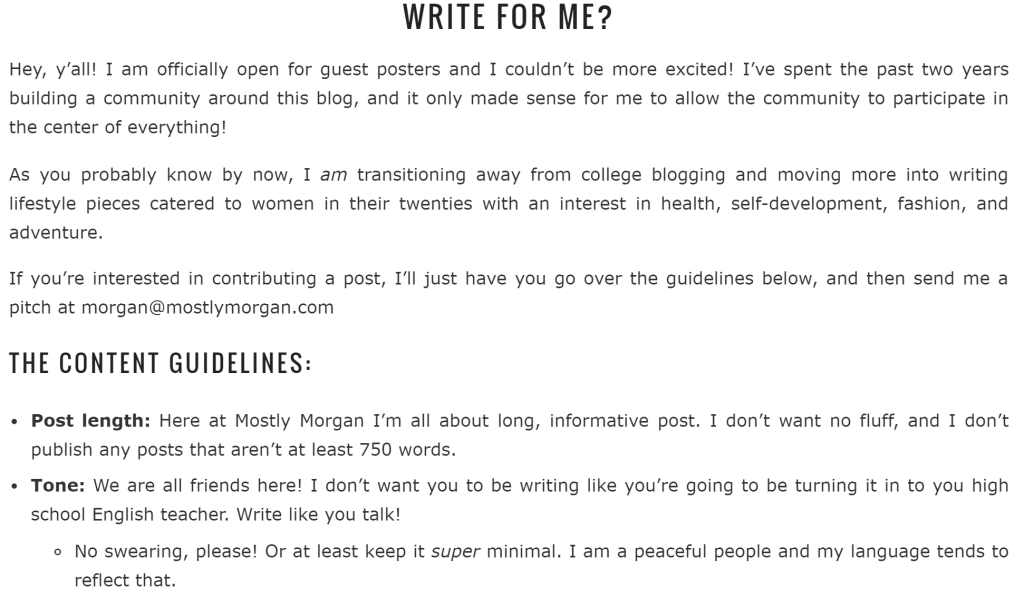Opening up your site for guest posters can be stressful. While guest posts are a great way to get a different perspective, an expert opinion, or a new voice on your blog, it’s scary knowing that their post might end up reflecting poorly on you and your business.
I recently opened Mostly Morgan up for guest posters and after a trial and error method of tweeting out the opportunity and hoping for the best, I’ve realized that Content Guidelines are a must.
You see, while I was able to get a handful of superb posts from doing a shout out for them on Twitter, I also got some not so great ones and I was left in the awkward position of telling prospective guest posters that I’d be unable to publish their post unless they made significant changes.
I felt like a bully and it was no fun.
Before we get into how to create content guidelines, I want to cover one important topic:
Why should we open our blogs to guest posters?
Before I go any further I will say this – you don’t have to allow guest posters on your site at all, but you might want to. I’ve found that guest posters are a great fit for my lifestyle site, but I’m a bit more picky here on my business site (though I have had one amazing one!). With that said, here are the benefits of guest posts:
- A traffic boost: Ideally you’ll be opening up the slot to somebody who has a similar audience to you, but not identical. The thought is that they can create a post that both of your audiences will love and from there they will drive traffic by promoting it on their social media. Their audience will come to your blog to read the post, and your audience will read the post and click over to their site and check them out.
- Building relationships: You know that I’m all about finding your blogging tribe, and once you find them a good way to say, ‘hey, I like you and what you’re doing’ is to offer them a spot on your blog. They might reciprocate, but even if they don’t you’re still getting a great post out of it.
- Consistency: If you want to publish twice a week it’s going to be a huge weight off of your shoulders if every fourth post is a guest poster. Writing eight posts a month might not seem difficult – but when you’re trying to balance your blog with work, school, family, friends, sleep, and life in general it can end up seeming pretty daunting.
‘”Now, Morgan. Give us the full story. What are the downsides of guest posters?”
Really, the only downside is that the post might be terrible and you’re left trying to explain to a well-intentioned blogger that you simply cannot publish what they’ve given you.
It’s awkward, trust me.
That is where content guidelines come in.
Even if you are given a terrible post, you can point to the content guidelines that you’ve already provided and say something like, “I really love the idea of your post, but I can’t publish it because you took a very aggressive tone and if you refer back to the content guidelines I like my site to stay friendly and upbeat.”
That sounds a lot better than, “You sounded rude and I don’t like that.”
You can make your content guidelines as strict or as loose as you want to. Personally, I like to cover all of my bases and I created a pretty in-depth guide.
I am going to cover the main points that you might want to include in your guidelines, but of course, you can omit some or add some, too.

What should you include in you content guidelines?
- Post length. If you are a stickler for post length like I am, you have to include this. I won’t publish a guest post that is shorter than 750 words for SEO reasons, and if my guest poster is used to writing 300-word posts they might look at my guidelines and realize we are not a great fit, which is fine!
- I recommend making your guest post requirements slightly shorter than the standard you hold for yourself. My personal posts typically are all at least 1000 words, but after adding in an introduction and the author bio to my guest poster’s submission it tends to meet that threshold.
- The tone. This one is super important. Whether you know it or not, your site probably has a very strong tone. You might be quirky, or informative, or friendly, or somewhere in between. Personally, I like to strike a balance between informative and friendly. With that said, I can’t have somebody submitting a very stiff and clinical sounding how-to post. People don’t need to replicate my voice, but I do want them to be warm, friendly, and inviting. I don’t want my readers to feel like they are being lectured to or talked at – instead, I want it to feel like a friend or older sibling giving advice.
- A good tip for this is to think about what audience your site is catered to. If your main demographic is women in their mid-twenties like mine is, you’re not going to want an overly prescriptive or stern voice, instead go with friendly and helpful. On the contrary, if you’re catering toward middle aged business men consider speaking a bit more formally and keep the slang to a minimum.
- Also, consider language use. I’m a gentle soul and don’t swear in my day to day life, so I don’t swear or use harsh language in my blog posts, either. It’s not who I am, and despite the big trend of swearing to seem relatable I simply wouldn’t be staying true to myself. Because my websites are an extension of my personal brand, I wouldn’t want guest posters to use excessive swearing, either.
- Final thing to think about – how big of a stylist stickler are you? For instance, I sometimes stumble upon blogs that write like they’re meant to please the blogger’s high school English teacher and I can’t get behind that style. I want posts on my site to sound like a friendly conversation, not a research paper.
- You may have noticed that I make a few of my own rules that will make all of you English majors cringe. Sorry! (I still love you.)
- The purpose. This is where a lot of would-be guest posters fall short. You should share what your site’s purpose is. Do you want to teach? To inspire? Or maybe you’re there to entertain. The way posts are written and formatted will likely be very different depending on your purpose. Mostly Morgan falls somewhere between teaching and inspiring, so I wouldn’t much benefit from a guest post with an anecdotal story and pretty pictures. On the other hand, some of my favorite blogs consist entirely of short stories and photography.
- Another way to phrase this is asking your potential guest posters to include the takeaway in their pitch. In other words, what will your audience gain from reading that guest post? Making people think about this before they pitch you should result in higher quality ideas.
- Photography. Personally, I prefer to have my guest posters provide photography along with their posts if they are able because I really like for them to have complete control of their vision. I ask for one vertical image, the rest horizontal. If they aren’t a photography wiz (and I don’t expect them to be!) I link them to my favorite free use stock photo site.
What if their post doesn’t meet the guidelines?
My editorial guidelines are brand new. Before I was just sending a few expectations via email and hoping that everything would be fine. Because they are new I haven’t had anyone submit according to them, but I have come up with a little template that y’all can use for inspiration:
“Hey there!
Thank you so much for submitting your post! I really appreciate it being on time – you are a rock star! I love the section where you _____________________, I had never thought of that!
One thing I’d love to tweak a bit, though, is the tone. You obviously know a lot about _______ and do an amazing job explaining the ins and outs. My audience tends to respond more favorably to a more casual tone, though, as mentioned in my editorial guidelines.
Would you be opposed to playing around with your tone? I can help if you have any questions!”
Do you let guest posters on your site? Have you had any ‘horror stories?’
